Matrix Method of Defect Analysis for Structures with Areas of Considerable Stiffness Differences
Abstract
1. Introduction
2. Materials and Methods
2.1. Formulation of Two-Dimensional Multi-Area Finite Elements. Theoretical Assumptions
- explicit, i.e., by analytical integration of the expression (4); in this way, the so-called explicit forms of the stiffness matrix are obtained in the form of formulas; explicit forms of the stiffness matrix are the most effective form of element matrix in computational analyses; however, difficulties arise related to their obtaining limit applications to the simplest elements of regular shapes (bar elements, two-dimensional rectangular elements, etc.);
- implicit, i.e., by numerical integration of the expression (4); in this way the stiffness matrix is obtained directly in numerical form; the Gauss–Legendre formula is often used and allows changing the integral expression into a summation expression; for example, for a function of one variable:where n is the number of integration points (so-called Gauss points), and and denote the weight and the value of the integrand function at the i-th integration point, respectively.
2.2. Stiffness Matrix Formulation for Four-Node Element
2.3. Eight-Node Elements
3. Numerical Tests
3.1. Heterogeneous Structure Composed of Square Elements 20 × 20 cm Containing Symmetrically Increasing Square Inclusions
- model with multi-area four-node elements, i.e., modified according to the presented method,
- model with four-node elements integrated in sub-areas with linear shape functions, i.e., without modification of the shape functions,
- reference model with standard discretization.
3.2. Cantilever Beam Composed of 20 × 20 cm Square Elements Containing Symmetrically Increasing Square Inclusions
- four-node elements with modification according to the presented method,
- four-node elements without modification of the shape functions,
- eight-node elements with modification according to the presented method,
- eight-node elements without modification of the shape functions,
- reference model with standard discretization.
4. Discussion
5. Conclusions
Author Contributions
Funding
Institutional Review Board Statement
Informed Consent Statement
Data Availability Statement
Conflicts of Interest
References
- Stachowski, A. Porous Materials as Future Application in Constructions. Kompozyty (Composites) 2001, 1, 224–227. [Google Scholar]
- Adamczyk, M.; Niżnik-Harańczyk, B.; Pogorzałek, J. The Effect of Melting Technologyof Steel with Addition of 3÷5% Al on the Type and Morphology of Non-Metallic Inclusions. Pr. Inst. Metal. Żelaza 2016, 68, 24–32. [Google Scholar]
- Addessi, D.; Mastrandrea, A.; Sacco, E. An Equilibrated Macro-Element for Nonlinear Analysis of Masonry Structures. Eng. Struct. 2014, 70, 82–93. [Google Scholar] [CrossRef]
- Caliò, I.; Pantò, B. A Macro-Element Modelling Approach of Infilled Frame Structures. Comput. Struct. 2014, 143, 91–107. [Google Scholar] [CrossRef]
- Liao, A.; Li, Y. A Super Element Model for Failure Analysis of Masonry Buildings under Lateral In-Plane Loading. Eng. Fail. Anal. 2025, 168, 109088. [Google Scholar] [CrossRef]
- Drougkas, A. Macro-Modelling of Orthotropic Damage in Masonry: Combining Micro-Mechanics and Continuum FE Analysis. Eng. Fail. Anal. 2022, 141, 106704. [Google Scholar] [CrossRef]
- Gaetano, D.; Greco, F.; Leonetti, L.; Lonetti, P.; Pascuzzo, A.; Ronchei, C. An Interface-Based Detailed Micro-Model for the Failure Simulation of Masonry Structures. Eng. Fail. Anal. 2022, 142, 106753. [Google Scholar] [CrossRef]
- Benkhechiba, A.E.; Guesmia, M.; Hachi, B.E.; Hachi, D.; Moussaoui, M. Contribution to the Modelling and Homogenization of 3D Structures in the Presence of Flaws by XFEM. Eng. Fail. Anal. 2020, 107, 104219. [Google Scholar] [CrossRef]
- Haghani, M.; Neya, B.N.; Ahmadi, M.T.; Amiri, J.V. A New Numerical Approach in the Seismic Failure Analysis of Concrete Gravity Dams Using Extended Finite Element Method. Eng. Fail. Anal. 2022, 132, 105835. [Google Scholar] [CrossRef]
- Kotšmíd, S.; Beňo, P. A Low Computational Cost Optimization Procedure for Axial Load Carrying Capacity of the Multi-Beam Structure. Eng. Fail. Anal. 2023, 143, 106922. [Google Scholar] [CrossRef]
- Cong, T.; Wang, J.; He, J.; Liu, Y.; Chen, Y.; Liu, F.; Li, L. Microstructure Evolution and Fatigue Crack Initiation Life Prediction of Actual Failed Bearings under GRCF Conditions. Eng. Fail. Anal. 2025, 169, 109148. [Google Scholar] [CrossRef]
- Ma, A.; Zhang, Y.; Dong, L.; Yan, H.; Fang, F.; Li, Z. Damage and Fracture Analyses of Wire with Off-Center Inclusion on Multi-Pass Drawing under Different Back Tensions. Eng. Fail. Anal. 2022, 139, 106512. [Google Scholar] [CrossRef]
- Dhanya, M.S.; Ranjith, R.; Manwatkar, S.K.; Kumar Gupta, R.; Narayana Murty, S.V.S. Metallurgical Investigation on Failure of Plain Carbon Steel Piston Rod Used in Hydraulic Jack: Role of Inclusions and Surface Roughness. Eng. Fail. Anal. 2023, 150, 107346. [Google Scholar] [CrossRef]
- Fan, Y.; Shuai, Y.; Shuai, J.; Zhang, T.; Zhang, Y.; Shi, L.; Shan, K. The Effect of Pipeline Root Weld Microstructure on Crack Growth Behaviour. Eng. Fail. Anal. 2024, 161, 108265. [Google Scholar] [CrossRef]
- Eshelby, J.D. The Determination of the Elastic Field of an Ellipsoidal Inclusion, and Related Problems The Determination of the Elastic Field of an Elli p Soidal Inclusion, and Related p Roblems. Proc. R. Soc. Lond. A Math. Phys. Sci. 1957, 241, 376–396. [Google Scholar] [CrossRef]
- Eshelby, J.D. The Elastic Field Outside an Ellipsoidal Inclusion. Proc. R. Soc. Lond. A Math. Phys. Sci. 1959, 252, 561–569. [Google Scholar] [CrossRef]
- Mazzucco, G.; Pomaro, B.; Salomoni, V.A.; Majorana, C.E. Numerical Modelling of Ellipsoidal Inclusions. Constr. Build. Mater. 2018, 167, 317–324. [Google Scholar] [CrossRef]
- Nguyen, S.-T.; To, Q.-D.; Vu, M.-N.; Nguyen, T.-D. Viscoelastic Properties of Heterogeneous Materials: The Case of Periodic Media Containing Cuboidal Inclusions. Compos. Struct. 2016, 157, 275–284. [Google Scholar] [CrossRef]
- Zhou, K.; Hoh, H.J.; Wang, X.; Keer, L.M.; Pang, J.H.L.; Song, B.; Wang, Q.J. A Review of Recent Works on Inclusions. Mech. Mater. 2013, 60, 144–158. [Google Scholar] [CrossRef]
- Pan, C.; Yu, Q. Inclusion Problem of a Two-Dimensional Finite Domain: The Shape Effect of Matrix. Mech. Mater. 2014, 77, 86–97. [Google Scholar] [CrossRef]
- Yvonnet, J.; Gonzalez, D.; He, Q.-C. Numerically Explicit Potentials for the Homogenization of Nonlinear Elastic Heterogeneous Materials. Comput. Methods Appl. Mech. Eng. 2009, 198, 2723–2737. [Google Scholar] [CrossRef]
- Cecot, W.; Oleksy, M. High Order FEM for Multigrid Homogenization. Comput. Math. Appl. 2015, 70, 1391–1400. [Google Scholar] [CrossRef]
- Ho, S.-P.; Yeh, Y.-L. The Use of 2D Enriched Elements with Bubble Functions for Finite Element Analysis. Comput. Struct. 2006, 84, 2081–2091. [Google Scholar] [CrossRef]
- Matsui, K.; Terada, K.; Yuge, K. Two-Scale Finite Element Analysis of Heterogeneous Solids with Periodic Microstructures. Comput. Struct. 2004, 82, 593–606. [Google Scholar] [CrossRef]
- Zhang, H.W.; Liu, Y.; Zhang, S.; Tao, J.; Wu, J.K.; Chen, B.S. Extended Multiscale Finite Element Method: Its Basis and Applications for Mechanical Analysis of Heterogeneous Materials. Comput. Mech. 2014, 53, 659–685. [Google Scholar] [CrossRef]
- Xing, Y.F.; Yang, Y. An Eigenelement Method of Periodical Composite Structures. Compos. Struct. 2011, 93, 502–512. [Google Scholar] [CrossRef]
- Xing, Y.F.; Du, C.Y. An Improved Multiscale Eigenelement Method of Periodical Composite Structures. Compos. Struct. 2014, 118, 200–207. [Google Scholar] [CrossRef]
- Xing, Y.; Gao, Y. Multiscale Eigenelement Method for Periodical Composites: A Review. Chin. J. Aeronaut. 2019, 32, 104–113. [Google Scholar] [CrossRef]
- Gao, Y.; Xing, Y.; Huang, Z.; Li, M.; Yang, Y. An Assessment of Multiscale Asymptotic Expansion Method for Linear Static Problems of Periodic Composite Structures. Eur. J. Mech. A/Solids 2020, 81, 103951. [Google Scholar] [CrossRef]
- Liu, H.; Sun, X.; Xu, Y.; Chu, X. A Hierarchical Multilevel Finite Element Method for Mechanical Analyses of Periodical Composite Structures. Compos. Struct. 2015, 131, 115–127. [Google Scholar] [CrossRef]
- Kim, S.; Lee, P.S. A New Enriched 4-Node 2D Solid Finite Element Free from the Linear Dependence Problem. Comput. Struct. 2018, 202, 25–43. [Google Scholar] [CrossRef]
- Ahmad, B.; Alsaedi, A.; Brezzi, F.; Marini, L.D.; Russo, A. Equivalent Projectors for Virtual Element Methods. Comput. Math. Appl. 2013, 66, 376–391. [Google Scholar] [CrossRef]
- Brezzi, F.; Marini, L.D. Virtual Element Methods for Plate Bending Problems. Comput. Methods Appl. Mech. Eng. 2013, 253, 455–462. [Google Scholar] [CrossRef]
- Desiderio, L.; Falletta, S.; Ferrari, M.; Scuderi, L. CVEM-BEM Coupling with Decoupled Orders for 2D Exterior Poisson Problems. J. Sci. Comput. 2022, 92, 96. [Google Scholar] [CrossRef]
- Desiderio, L.; Falletta, S.; Scuderi, L. A Virtual Element Method Coupled with a Boundary Integral Non Reflecting Condition for 2D Exterior Helmholtz Problems. Comput. Math. Appl. 2021, 84, 296–313. [Google Scholar] [CrossRef]
- Chyży, T.; Mackiewicz, M. Special Finite Elements with Adaptive Strain Field on the Example of One-Dimensional Elements. Appl. Sci. 2021, 11, 609. [Google Scholar] [CrossRef]
- Available online: https://maxima.sourceforge.net (accessed on 1 March 2025).
- Chyży, T.; Mackiewicz, M.; Matulewicz, S. Modern Graphic Language for Description of Building Structures, Orcan Ver. 0.91. 2014. (In Polish). Available online: http://orcanfree.pl/Instrukcja%20ORCAN%20v.4.pdf (accessed on 1 March 2025).
- ANSYS Inc. Ansys R2; Computer Program; Ansys: Canonsburg, PA, USA, 2022. [Google Scholar]




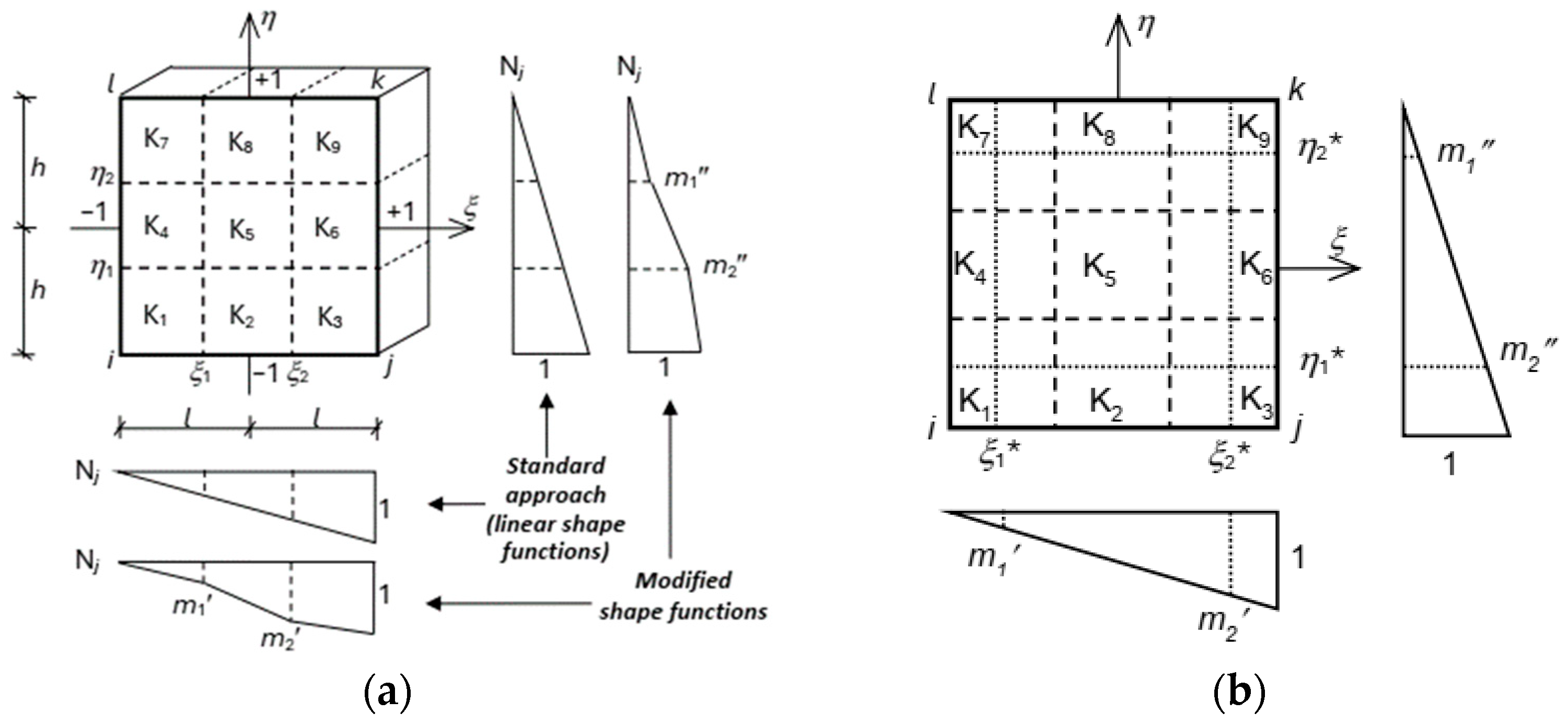

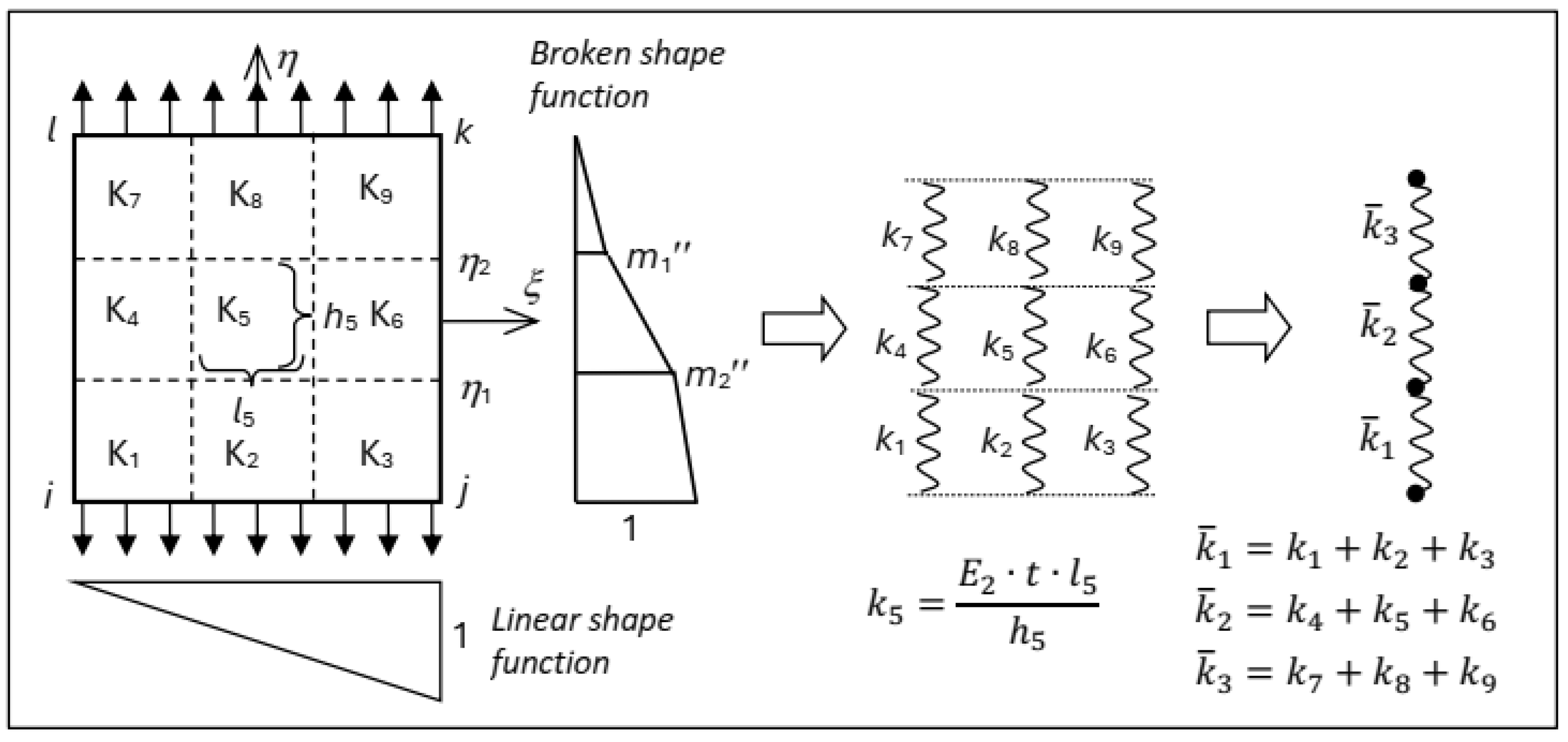
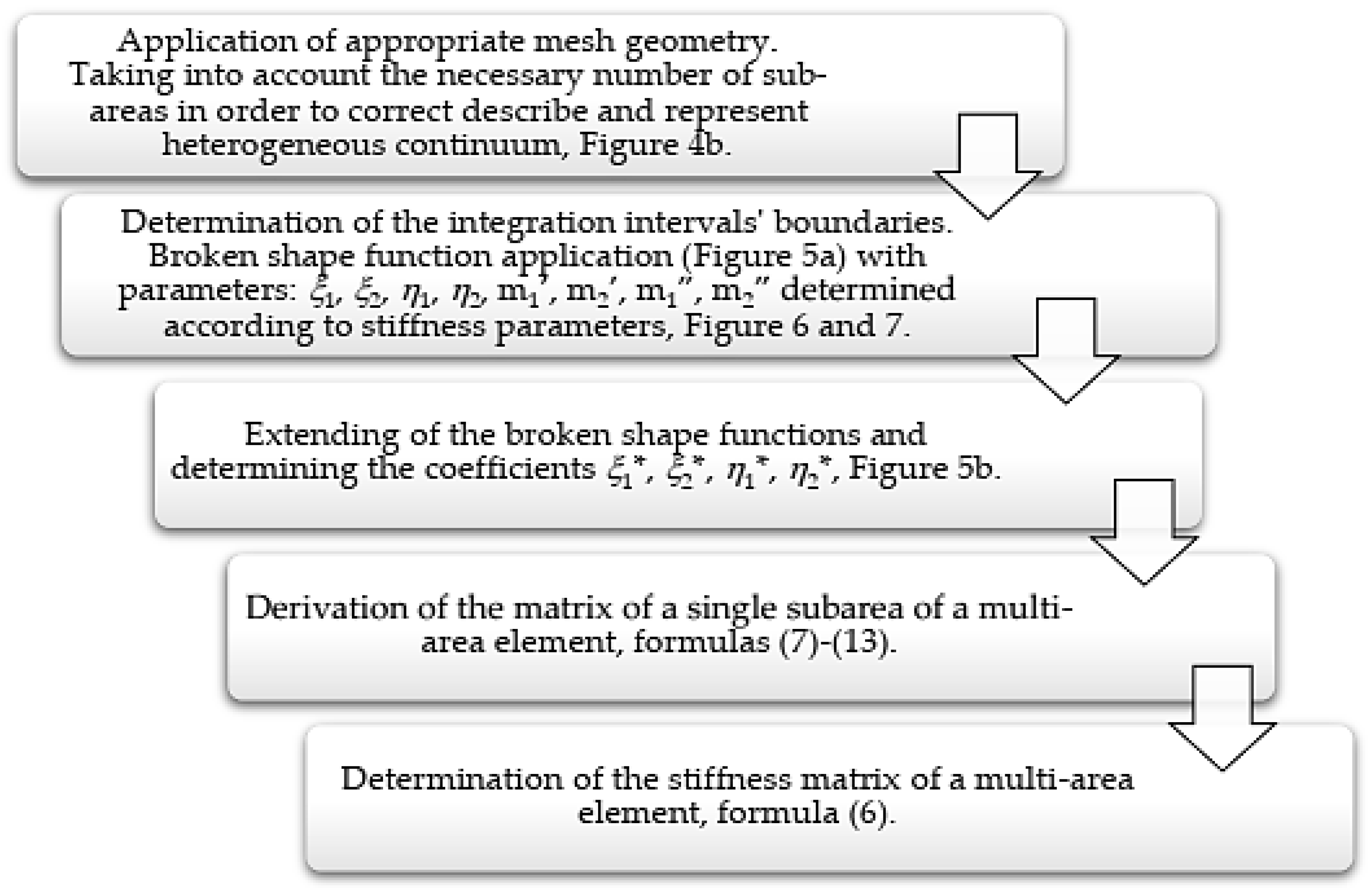
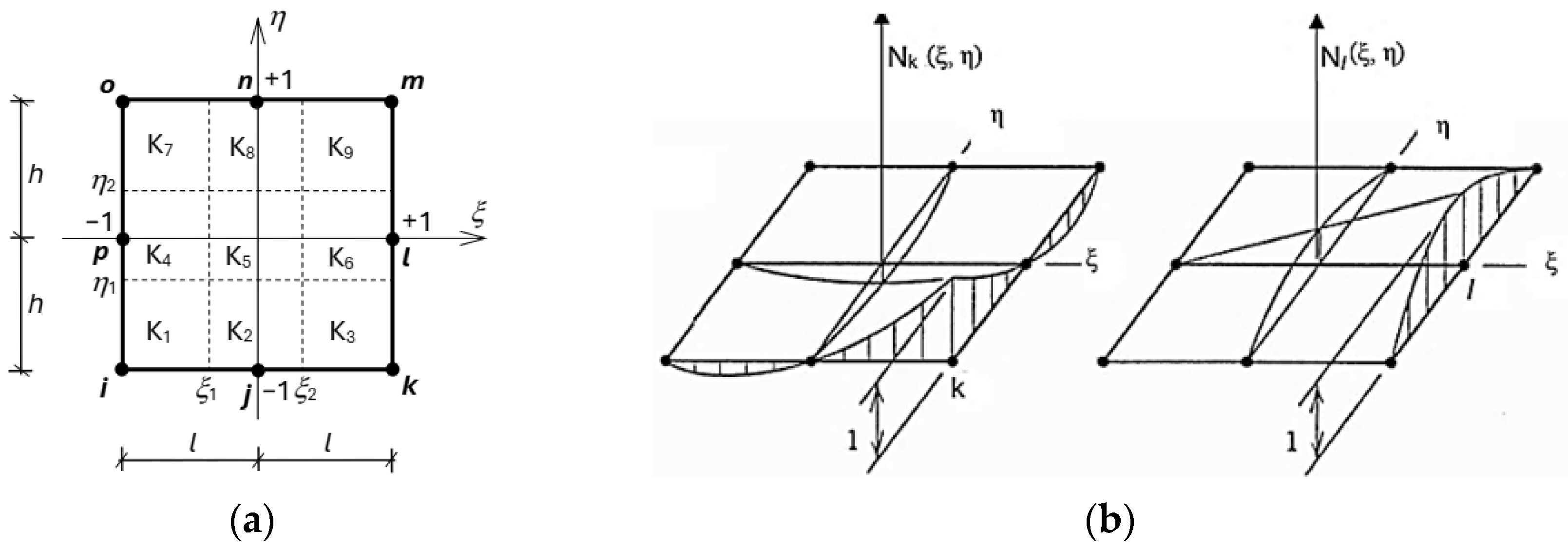
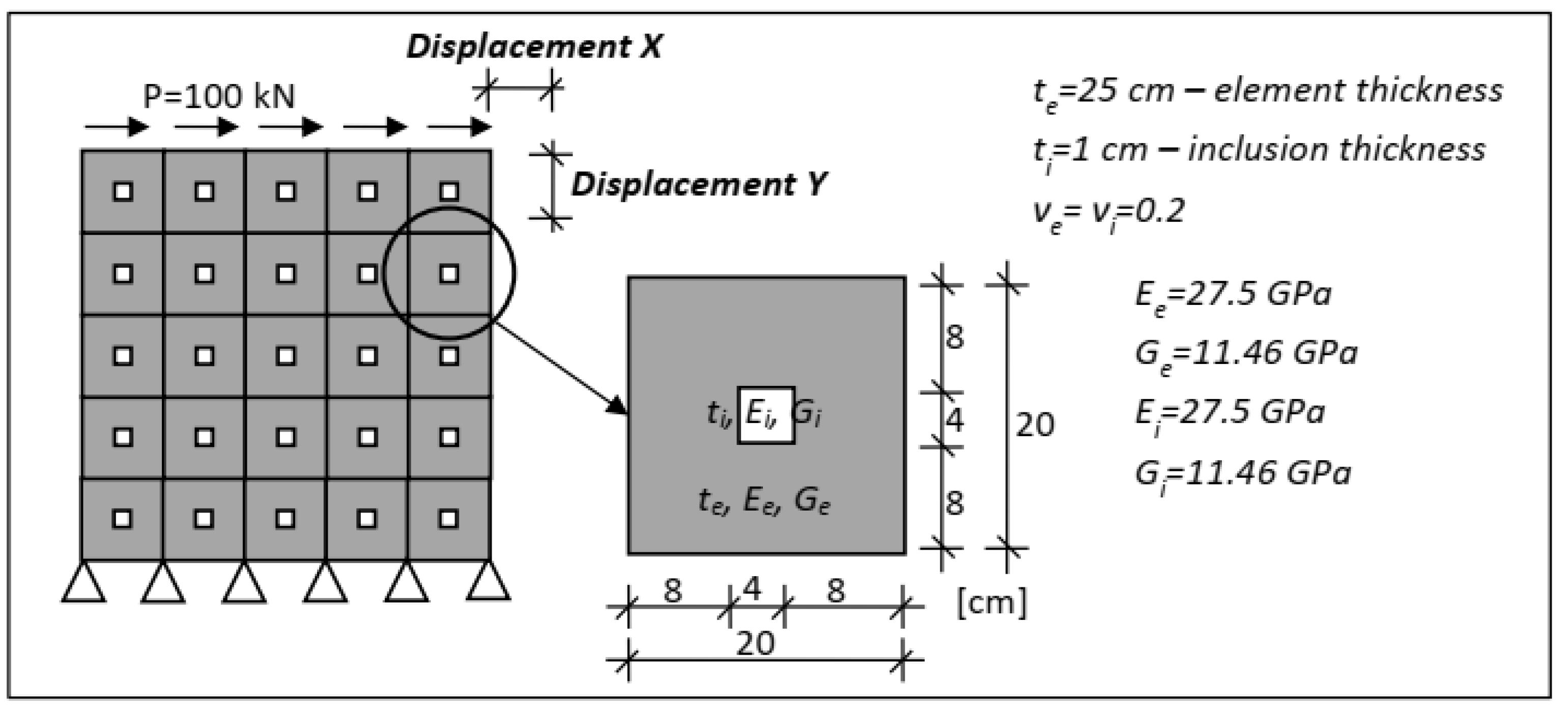
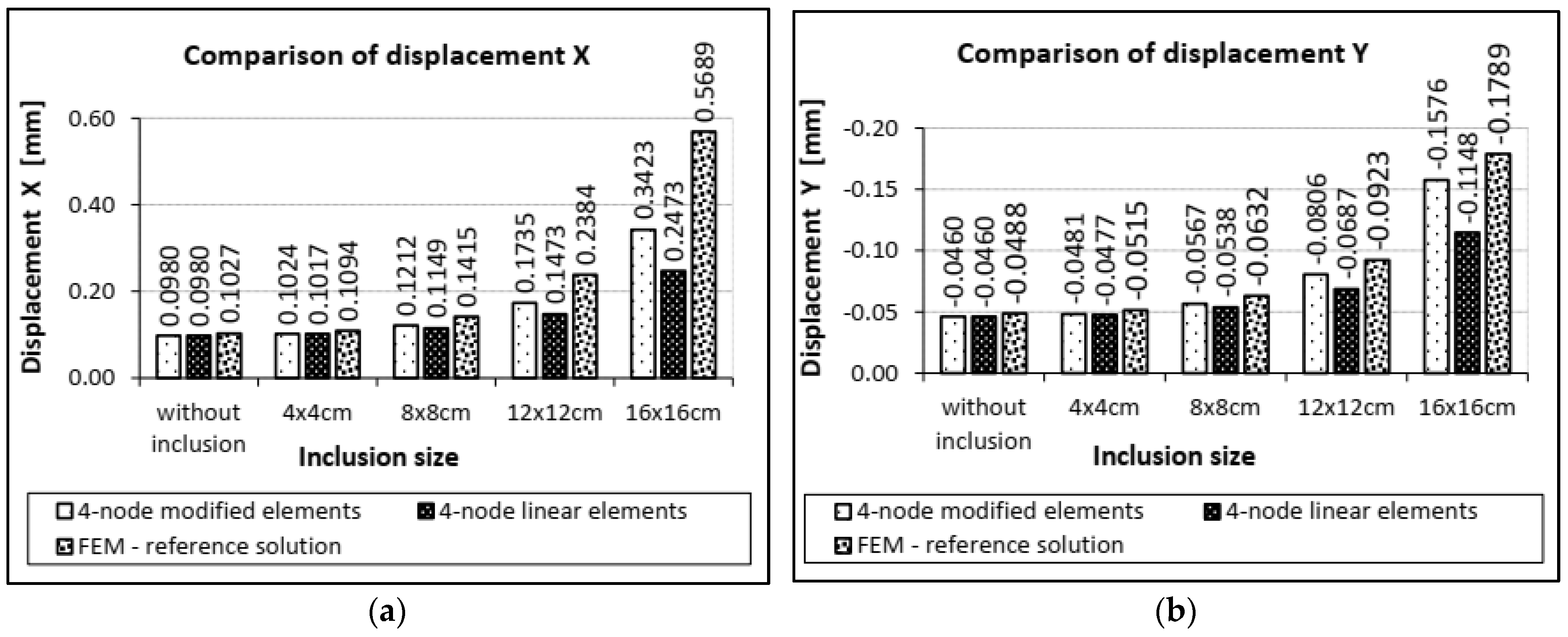
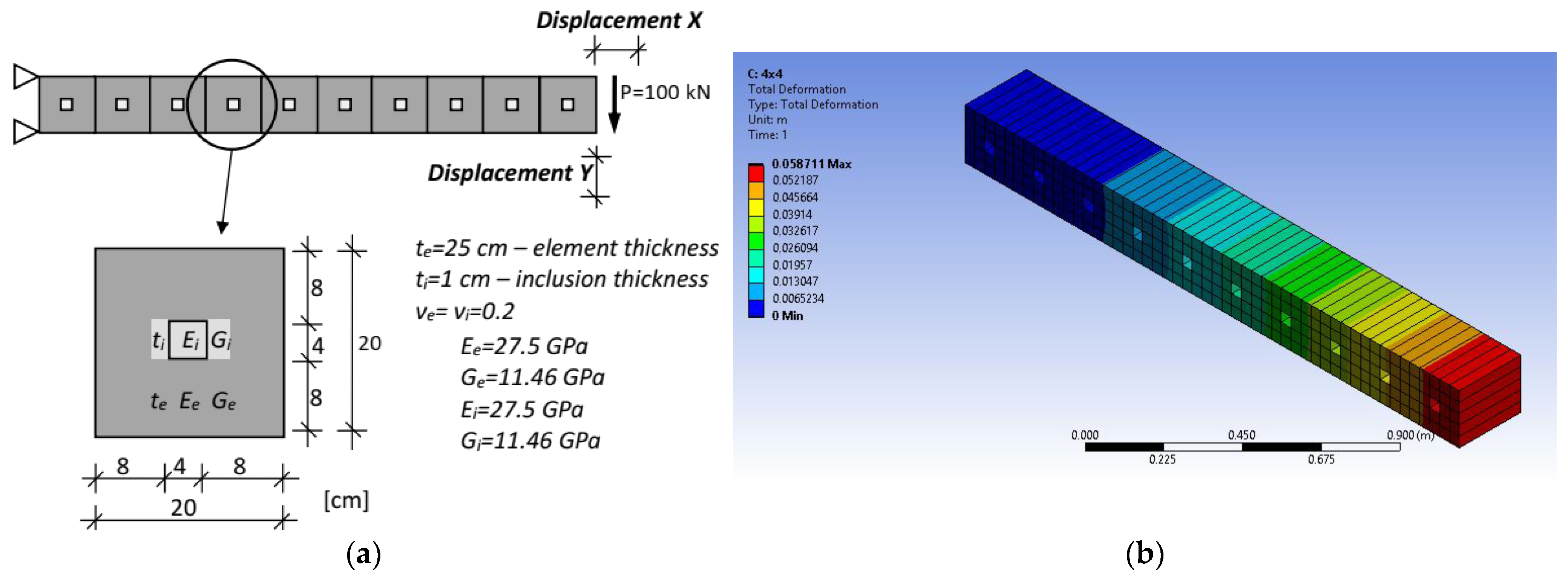
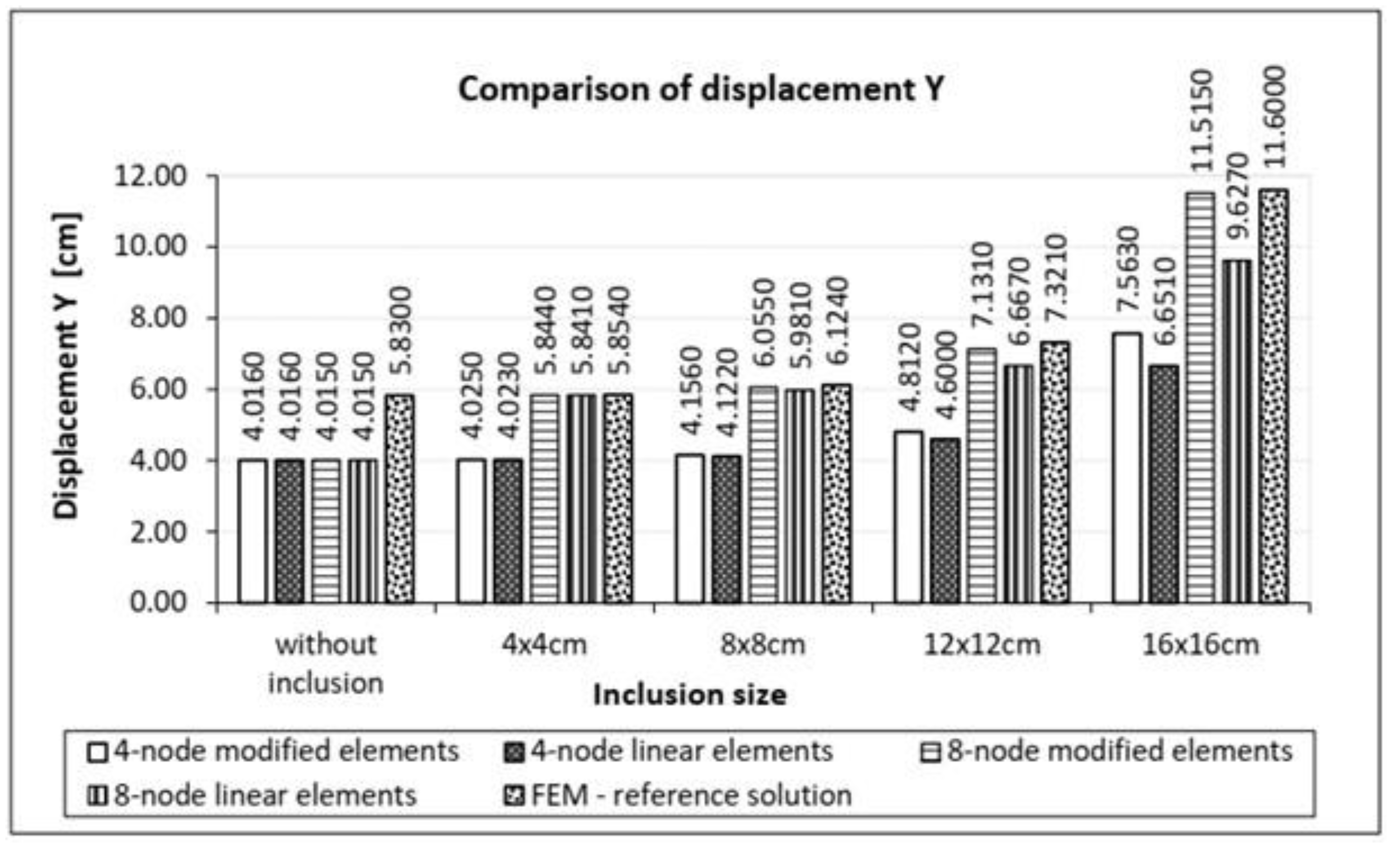

Disclaimer/Publisher’s Note: The statements, opinions and data contained in all publications are solely those of the individual author(s) and contributor(s) and not of MDPI and/or the editor(s). MDPI and/or the editor(s) disclaim responsibility for any injury to people or property resulting from any ideas, methods, instructions or products referred to in the content. |
© 2025 by the authors. Licensee MDPI, Basel, Switzerland. This article is an open access article distributed under the terms and conditions of the Creative Commons Attribution (CC BY) license (https://creativecommons.org/licenses/by/4.0/).
Share and Cite
Mackiewicz, M.; Chyży, T. Matrix Method of Defect Analysis for Structures with Areas of Considerable Stiffness Differences. Appl. Sci. 2025, 15, 4484. https://doi.org/10.3390/app15084484
Mackiewicz M, Chyży T. Matrix Method of Defect Analysis for Structures with Areas of Considerable Stiffness Differences. Applied Sciences. 2025; 15(8):4484. https://doi.org/10.3390/app15084484
Chicago/Turabian StyleMackiewicz, Monika, and Tadeusz Chyży. 2025. "Matrix Method of Defect Analysis for Structures with Areas of Considerable Stiffness Differences" Applied Sciences 15, no. 8: 4484. https://doi.org/10.3390/app15084484
APA StyleMackiewicz, M., & Chyży, T. (2025). Matrix Method of Defect Analysis for Structures with Areas of Considerable Stiffness Differences. Applied Sciences, 15(8), 4484. https://doi.org/10.3390/app15084484





